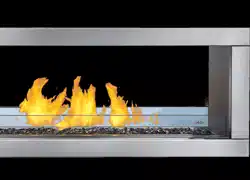Loading ...
Loading ...
Loading ...

W415-3006 / A / 05.27.21
EN
26
7.0 gas installation
!
WARNING
• Risk of fire, explosion or asphyxiation. Ensure there are no ignition sources such as sparks or open flames.
• The installation must be performed by a licensed gas fitter, and all connections must be leak tested before
operating the appliance.
• All gas connections must be contained within the appliance when complete.
• High pressure will damage the valve. Disconnect gas supply piping before testing gas line at test pressures
above 1/2 psig.
• Connect the gas supply in accordance to local codes. In the absence of local codes, install to the current CAN/
CSA B149.1 Installation Code in Canada or to the current National Fuel Gas Code, ANSI Z223.1/NFPA 54 in
the United States.
• Leak test all the connections by brushing on a soap and water solution. These connections can be accessed
by removing the burner.
Installation and servicing to be done by a qualified installer.
• Move the appliance into position and secure.
• If equipped with a flex connector, the appliance is designed to accept a 1/2” (13mm) gas supply. Without the-
connector, it is designed to accept a 3/8” (9.5mm) gas supply. The appliance is equipped with a manual shut off
valve to turn off the gas supply to the appliance.
• Connect the gas supply in accordance to local codes. In the absence of local codes, install to the current CAN/
CSA-B149.1 Installation Code in Canada or to the current National Fuel Gas Code, ANSI Z223.1 / NFPA 54 in
the United States.
• When flexing any gas line, support the gas valve so that the lines are not bent or kinked.
• The gas line flex-connector should be installed to provide sufficient movement for shifting the burner assembly
on its side to aid with servicing components.
• Check for gas leaks by brushing on a soap and water solution. Do not use open flame.
After installing the electrical wiring and gas lines, ensure to test the appliance before finishing the framing and
finishing the appliance. Purge the gas supply line of any trapped air prior to the first firing of the appliance.
Your appliance can be converted to use propane gas using the certified conversion kit.
7.1 gas hook-up
!
WARNING
• If these instructions are not followed exactly, a fire causing death or serious injury may occur.
• A fire will result if the gas supply hose makes contact with the underside of the appliance.
7.2 propane cylinder specifications
A dented or rusty cylinder may be hazardous and should be checked by your propane supplier. Never use
a cylinder with a damaged valve. The propane gas supply cylinder must be constructed and marked in ac-
cordance with the U.S. D.O.T. Specifications for Propane Gas Cylinders or the Standard for Cylinders,
Spheres and Tubes for Transportation of Dangerous Good and Commission, CAN/CSA-B339, as applicable.
This appliance has been designed for use with a 20lb (9.1kg) or 30lb (13.6kg) size propane cylinder only (not supplied).
The propane gas suppy cylinder must be provided with a cylinder-connection device compatible with the connec-
tion for the appliance. The propane cylinder must be provided with a shut-off valve terminating in a propane cylinder
valve type QCC1, and a safety relief device having direct communication with the vapour space of the cylinder. The
cylinder supply system must be arranged for vapour withdrawal and the cylinder shall include a collar to protect
the cylinder valve. The propane gas cylinder must be provided with a listed overfill protection device (OPD). Do
not store a spare propane gas cylinder under or near this appliance. Never fill the cylinder beyond 80 percent full.
Use only the pressure regulator and hose assembly provided with this appliance. Replacement pressure regulators
and hose assemblies must be specified by the manufacturer. The regulator supplies a pressure of 11 inches water
column to the appliance and has a QCC1 type fitting. Cylinders to be used with this appliance must be supplied with
QCC1 cylinder valve. A QCC1 cylinder has a positive seating connection, which will not allow gas flow until a positive
seal has been achieved. It is also equipped with an excess flow device. In order to attain full flow to the appliance,
the valve must be in the off position when the cylinder valve is turned on.
Loading ...
Loading ...
Loading ...
